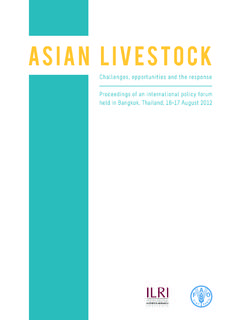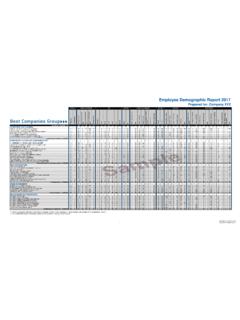Transcription of Growth and Production of Sugar Cane - …
1 UNESCO EOLSSSAMPLE CHAPTERSSOILS, PLANT Growth AND CROP Production - Growth and Production of sugarcane - Willy Verheye Encyclopedia of life Support Systems (EOLSS) Growth AND Production OF sugarcane Willy Verheye National Science Foundation Flanders and Geography Department, University of Ghent, Belgium Keywords: Bagasse, gur, jaggery, molasses, nobilization, ratoon crop, raw Sugar , sucrose, Sugar cane , virgin cane . Contents 1. Introduction 2. Botany Cultivars and Classification Structure Propagation and Pollination 3. Ecology and Growing Conditions Climate Temperature Rainfall and Water Supply Sunshine and Photoperiodicity Wind Soils Physical Aspects Chemical Aspects 4. Crop and Land Husbandry Field Layout and Land Preparation Planting Growth Cycle and Crop Rotation Fertilization Maintenance Pests and Diseases Bacterial Diseases Fungal Diseases Viral Diseases Pests Nematodes Harvest Yield 5.
2 cane Processing 6. Utilization and Use 7. Production and Trade Glossary Bibliography Biographical Sketch Summary UNESCO EOLSSSAMPLE CHAPTERSSOILS, PLANT Growth AND CROP Production - Growth and Production of sugarcane - Willy Verheye Encyclopedia of life Support Systems (EOLSS) Sugar cane is a perennial grass that thrives well in tropical and frost-free warm temperate areas. It requires high temperatures, plenty of sunlight, large quantities of water (at least 1500 mm of rain per year unless grown with irrigation), fertile soils, and good drainage. The crop cycle varies between 10 and 24 months, but can be extended four times or more by additional ratoon cropping. cane is harvested after 12 to 18 months for most plant crops, after 12 months for ratoon crops. In modern, fully mechanized cultivation areas, as is the case in the US and Australia, the growing period may be considerably shorter, with plant cane harvested 9 months after spring emergence, and 7-8 months for ratoon crops.
3 Harvesting is generally done in the dry period and when the stalks contain the maximum amount of sucrose. Sugar cane is a Gramineae, tribe Andropogenae which contains 6 species. The currently cultivated crop (Saccharum spp.) is an inter-hybrid cane with high Sugar content. Propagation is mainly in a vegetative way with 30-40 cm-long fresh cuttings. Average yields are around 90-100 tons/ha for the first planting, and between 40 and 60 tons/ha for the ratoon crops. Smallholders plantations yield on average 15-20% lower. Fully-mechanized crops in the US (Hawai , Louisiana) and Australia may yield up to 200 tons/ha. Sugar cane provides the cheapest form of energy food with the lowest unit of land area per unit of energy produced. The crop was originally used for chewing, but is now almost exclusively grown for the Production of Sugar as a food sweetener or for the Production of ethanol for motor fuel.
4 Most of the manufacturing process for extracting the sucrose from the cane is done at or nearby the plantation. Only the final refining of the Sugar takes place in the importing countries. 1. Introduction Sugar cane (Saccharum spp.) is a perennial grass and one of the few plants which stores its carbohydrate reserves as sucrose. Its economic value lies in the stalks, and the Sugar /sucrose they contain after crushing. Sugar cane supplies more than half of the world s Sugar consumption. In Brazil, it is moreover a major component of biofuel. Other plants producing sucrose are: Sugar beet, Sugar maple, sorghum and a few palms. cane and beet Sugar are indistinguishable in terms of composition and quality, and thus serve to supplement each other. In other words, the source of the crop is of little importance as long as the final product is near pure sucrose.
5 Sugar cane is currently grown on estates and by smallholders. The establishment of a nucleus estate around the Sugar mill is both to compensate for the short-term fluctuations in the cane supply to the mill, and to be assured that freshly-cut cane can be rapidly processed. To be economically viable such an estate should constitute a more or less uniform block of 3,000 to 4,000 ha. Smallholders cultivate however smaller fields and either deliver the cane to the factories on the estates (outgrowers) or process their cane themselves into brown Sugar (gur or jaggery). Traditionally, Sugar cane was grown in developing countries where much unskilled labor was available for harvesting. When the crop extended into industrial countries field preparation and harvest were gradually mechanized.
6 In the US the Sugar cane UNESCO EOLSSSAMPLE CHAPTERSSOILS, PLANT Growth AND CROP Production - Growth and Production of sugarcane - Willy Verheye Encyclopedia of life Support Systems (EOLSS) industry varies between Production areas. In Louisiana individual owners produce cane for the local mills, and farms range from 200 to 2000 ha in size. In Florida, most of the cane is produced by large companies, although some is also produced by individual growers. In Brazil, the mill size varies greatly, with some individual mills having a capacity to threat the yield of 75,000 ha or more. Sugar cane originates from New Guinea and the South Pacific, where it was mainly used for chewing. From there it progressed westwards, especially under the form of the hybrids Saccharum sinense (in China) and S.
7 Barberi (in India). During the conquest of India by Alexander s army in 326 BC Sugar from cane was reported as honey produced from reeds . By 500 BC S. barberi had reached Persia and the Mediterranean region, where it took its mark as a source of Sugar and food sweetener in Syria, Cyprus, Crete, Sicily, etc. The Arabs introduced it in AD 641 in Egypt, in Morocco and in Spain (introduced in AD 714), and by AD 1150 there were 30,000 ha of Sugar cane under cultivation in Spain. In the 15th century the Portuguese brought canes to Madeira and subsequently to the Canaries and Western Africa. Columbus took them in 1493 to Hispaniola (where they first disappeared) and a second time in 1506. The first West Indian Sugar was made in Hispaniola, now Haiti and the Dominican Republic, in 1509.
8 The crop was later taken to Mexico in 1520, Brazil in 1532, Peru in 1533. In the US, Sugar cane cultivation did not become established until the 18th century. Its development is closely linked to the introduction of slave labor. For more than two centuries only one variety, S. barberi (Cana Criolla) was grown in the New World. Towards the end of the 19th century it was replaced in Brazil by S. sinense, which was hardier and more resistant to several diseases. S. sinense was then introduced into Mauritius and into Natal in 1882. The present day Sugar cane varieties have been the subject of many improvements. The original S. spontaneum and S. robustum were rapidly replaced by S. barberi and S. sinense (see above), but were themselves ousted later by S. officinarum or noble cane .
9 The latter is the result of numerous intra-specific and inter-specific crosses, and is characterized by a good productivity and high sucrose (or saccharose) content, and a low proportion of fiber. The term nobilization has been coined to describe this process of improvement. The evolution described above was to a large extent driven by different uses of the plant. Originally, Sugar cane was grown solely for chewing, mainly in the Pacific and Southeast Asia. Thick noble canes which are relatively soft with a higher Sugar and juice content and low fiber are the best for chewing. Over time, cane became a source for sweetening food. The Production of Sugar by boiling the juice was first discovered in India, probably in the first millennium BC, where the preparation of Sugar from palms was already known.
10 This form of raw Sugar is known as gur in India, jaggery in Africa, or panela in Latin America. Raw Sugar made in the producing countries is now often refined in importing countries by washing and removing the last traces of impurities. The end product is a fine, almost pure white Sugar . UNESCO EOLSSSAMPLE CHAPTERSSOILS, PLANT Growth AND CROP Production - Growth and Production of sugarcane - Willy Verheye Encyclopedia of life Support Systems (EOLSS) Since the Middle Ages Sugar from cane has largely replaced honey as a sweetener. At the beginning it was considered a luxury and costly product. With the development of the Sugar industry in the 18th century in the New World Sugar became much more plentiful and cheaper worldwide. 2. Botany Cultivars and Classification Sugar cane (Saccharum spp.)
















